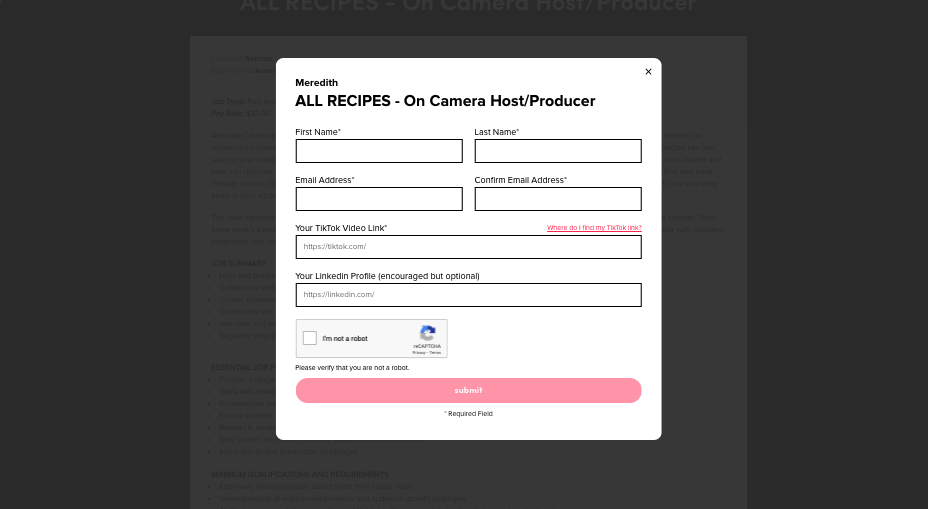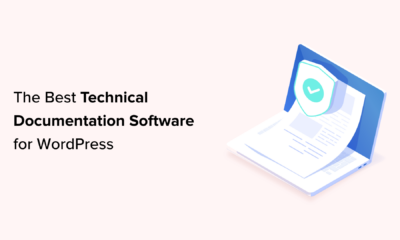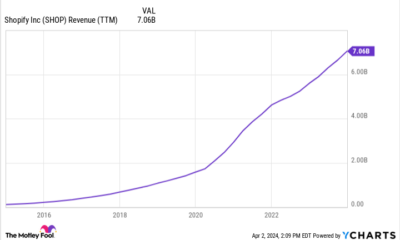TikTok wants you to send video resumes directly to brands to land your next gig

A new pilot program from TikTok would inject a little LinkedIn into the youthful video-based social network.
TikTok announced that, starting today, it will invite users to submit video resumes to participating companies, including Target, Chipotle, Shopify, Meredith, NASCAR and the WWE. The company encourages applicants to show off their skills in a creative way while tagging the content with the hashtag #TikTokResumes.
The pilot program is TikTok’s latest effort to streamline the relationship between brands and creators, giving both even more reason to invest time and cash into the platform.
“#CareerTok is already a thriving subculture on the platform and we can’t wait to see how the community embraces TikTok Resumes and helps to reimagine recruiting and job discovery,” TikTok Global Head of Marketing Nick Tran said of the pilot.

The new pilot program will be discoverable through the dedicated hashtag and on standalone site tiktokresumes.com, which also has some tips for applying and sample videos. On that site, anyone can browse job listings by employer and fill out a short questionnaire, attaching their video link. And yes, for better or worse, pointing potential employers to your LinkedIn profile is still encouraged.
TikTok views the new pilot as a “natural extension” of its college ambassador program, which recruits students to serve as on-campus representatives promoting the social network’s brand. The pilot program will accept TikTok resumes through July 31.
Of the participating brands listed on the new site, many openings are just for regular ol’ jobs, like NASCAR seeking a sales rep and Target hunting for hourly warehouse workers to cover the night shift. (Should we really be encouraging unemployed people to jump through more hoops to land gigs like this?)
Some listings are more tailored to the TikTok skill set, like an opening at All Recipes for on-camera talent to teach viewers how to make fluffy biscuits or a supervising social producer role at Popsugar.
The traditional resume hasn’t changed much over the years — list the stuff you did, keep it on one page — but any brand hiring a social media manager or any other kind of content creator could be well served by TikTok’s latest creator economy experiment.
3 ways to recruit engineers who fly under LinkedIn’s radar

Sergiu Matei is the founder of Index, a platform that helps teams find and hire world-class remote software developers and be globally compliant from the get-go.
We’ve recently been bombarded with news of job surpluses, including predictions that the number of software developer roles will increase 22% by 2030. With the need for nearly a quarter more developers, recruiters are having to scale their search and look under the stones that have previously been left unturned.
It’s easy to assume in the digital age that job candidates are waiting at the end of a mouse click, but the online hiring space isn’t as encompassing as we think. Less than 10% of people on LinkedIn don’t have an education that surpasses high school, despite 87% of developers having taught themselves a new coding language, framework or tool without formal education.
People who live in emerging markets use LinkedIn less frequently, even though these locations harbor some of the world’s most promising tech talent.
Some developers choose not to have a LinkedIn account because it feels like another social media channel to maintain. This aversion makes sense considering engineers focus more on hard skills rather than their online personae.
This week, LinkedIn announced it would start offering its services in Hindi, which will allow the service to reach 600 million people globally. People who live in emerging markets use the platform less frequently, even though these locations harbor some of the world’s most promising tech talent.
Companies can’t let how they’ve hired in the past influence their approach today — doing so means missing not just the quantity of developers, but the quality and diversity of them. The remote revolution didn’t just broaden where we can recruit, it’s expanded who we can bring on board. With that in mind, these are the best ways to tap into the hidden developer gems.
Open up your content, chats and code
No recruiter should think of hiring a developer as the same process as selling a product or service. As Adam DuVander explains in “Developer Marketing Does Not Exist,” resonating with developers requires more education and less promotion than the majority of companies currently provide.
The content you publish can organically pique people’s interest, as long as it has a strategic purpose and doesn’t overly mention your brand or services; for example, blog posts about upskilling, industry trends and exclusive data insights. You could also host events like webinars, round tables, quizzes and hackathons that are less for recruitment purposes and more to showcase the team and culture. Don’t be afraid to be lighthearted with your content, either. Memes, GIFs and videos are a great way to demonstrate that you don’t take yourself too seriously. And once you remove the promotional positioning, developers in the shadows will start to come forward.
People Buy People On LinkedIn Not Companies: Here’s Why

On LinkedIn, people buy into other people, not companies. LinkedIn is all about you, the leader. When people make decisions, it is based on who you are, how they feel about you and other emotional, sometimes intangible feelings. This is true for social media and in real life.
Gut reactions, good vibe, rapport — people build up a trust with you, or not as the case may be. That’s why authenticity is key. People will find out if you’re fake. And since people on LinkedIn buy into other people, that’s why the best course to get more business is to market your company through your personal page on LinkedIn.
I’ve written before about what I call “the Richard Branson effect,” which can easily be replaced with the Elon Musk effect, the Bill Gates effect or any other public figure in business. These types of company leaders have more engagement and followers on LinkedIn than their respective companies. One hundred times more people follow the leader and founder of Virgin Atlantic, Richard Branson, than the company itself.
People buy people. People follow people, not companies. Even when leaders like Michael Dell have fewer followers than their company page, they actually have more engagement levels for their posts.
As another example, if you look at the Microsoft company page on LinkedIn (and bearing in mind that they own LinkedIn), the company has 14 million followers, but sometimes its posts get literally zero comments. They tend to be boring company updates about diversity, the environment, Azure, the Surface products. Who cares?
So, you have to wonder, if Microsoft often gets such little engagement on LinkedIn, then how do small companies have a chance? You have to keep in mind that when the CEO of Microsoft, Satya Nadella, posts, he routinely gets hundreds of thousands of engagements. People buy into Satya, and when he talks about Microsoft, people listen.
They see more authenticity in Satya. It feels more personal. You can’t take the company to the pub, cafe or restaurant but you can take the CEO or Founder.
It’s often the best place to do business in a bar. This is where the real action happens and where the real “you” comes out. You have a drink, you relax, you build a rapport and you share. You then start trusting one another and that’s how business is done. You can’t take a company out for a drink.
I closed my physical office in Singapore, and I have all my meetings at the W Hotel’s WooBar. I invite people to come and meet me there as it’s a break for them away from their home or physical office in the business district.
Their decision of whether to outsource to my company is often based on how well they get along with me. It can of course go both ways. The ones who enjoy my sometimes polarizing personal brand often become my clients. The whole process is based on social selling, not hard selling.
Build a relationship socially with potential clients. Share the good, bad and ugly about yourself on LinkedIn. You then gain permission in other people’s view to share your company through your personal page on LinkedIn. People will come to trust you and buy your service because of you.
Ultimately, selling is about people, trust, rapport and relationships, and you can’t do that through a company website or a company page on LinkedIn; you can only do it through you and your personal page and brand.
So, my advice is don’t waste time on your LinkedIn company page, and instead focus on your LinkedIn personal page to see results. The examples of successful business personalities speak for themselves.
Forbes Business Council is the foremost growth and networking organization for business owners and leaders. Do I qualify?
8 Tools that are a Must for LinkedIn Automation – Times News Express

When it comes to social media platforms, LinkedIn might come across as Facebook’s older, more responsible, and infinitely more boring sibling. When it comes to functionality, however, it is an invaluable resource to professionals all across the globe. As of 2021, LinkedIn has more than 774 million registered members from more than 200 countries, and savvy HR and marketing-minded professionals would be wise not to overlook the vast array of resources it offers.
From networking to brand building, to publishing, LinkedIn can provide a multitude of services. However, all of these options and the wealth of data can potentially hamper efficiency and productivity.
Here are the seven must-have Linkedin automation tools that will help get the results you want in less time.
Lead generating software that responds at the click of a button is good. Software that runs in the background while you accomplish tasks elsewhere is even better. For example, Castanet can manage single or multiple LinkedIn profiles and continuously run to automatically generate appointment requests, connection invitations, and skill endorsements.
Searches can be precisely filtered by LinkedIn profile characteristics in order to seek out quality clients who are more likely to have an interest in your company and the products or services you offer. When you have a connection with your clients, it means better leads and less wasted time on undesirable prospects.
Dux-Soup is a sales tool focused on automated lead generation. Based upon the parameters you set, it automatically contacts sales prospects selected on LinkedIn. It can also send direct messages, endorse skills, send personalized connection requests. A handy feature is its ability to schedule multiple, delayed, personalized messages.
Crystal is an excellent source of information for both sales and HR professionals. It is able to mine data from LinkedIn profiles to predict communication styles and personality types and therefore give you a better idea of how best to approach customers, coworkers, and prospective employees.
Using the DISC personality method, Crystal also offers various training courses to show you how to implement your acquired data into the most effective processes for team building, hiring, and sales generation.
LeadFeeder uses web tracking technology to identify what companies visit your website and are potentially interested in your services. It is beneficial for gauging the effectiveness of your marketing efforts, as it also tracks how visitors find your website and the path they take. It can even offer data on the specific portions of your website being viewed.
One strange downside of LinkedIn is the overabundance of users and potential sales opportunities. LeadFuze uses powerful filters to narrow down prospects, generate lead lists, and acquire verified personal email addresses to initiate contact.
On the HR side, LeadFuze can run filters to search for potential candidates across LinkedIn who are not actively searching for a job. The LeadFuze search allows hiring managers to find contact information for quality individuals who would be unlikely to apply for posted job offerings independently.
LinkedIn Sales Navigator is added via a simple Chrome extension. It allows you to view LinkedIn profile data if you are emailing someone with a corresponding Gmail account. The LinkedIn Sales Navigator account gives you additional information about them as you’re engaging in direct contact, making it easier to tailor your communication to the specific individual you’re dealing with.
When trying to gather as much information about a potential client as possible, it can sometimes be an arduous process to search throughout the various social media platforms for the same individual or company. Discoverly streamlines that process by gathering all the information from the most commonly used social media sources and compiling each person or company’s social media presence all in one place.
No more logging into five different places to get a comprehensive view of a prospective client’s web presence. Instead, Discoverly lets you toggle between all the platforms in one location for quick searching abilities.
Conclusion
Whether you’re using LinkedIn to build your brand, generate sales leads, or expand your hiring search, the actual platform can contain so much data that streamlining is necessary. These after-market tools and plugins can help you navigate LinkedIn and make the most out of all the resources at your disposal.
Image Credit: pixabay; pexels; thank you!
The post 8 Tools that are a Must for LinkedIn Automation appeared first on Calendar.
-

 PPC4 days ago
PPC4 days ago19 Best SEO Tools in 2024 (For Every Use Case)
-

 PPC7 days ago
PPC7 days ago4 New Google Ads Performance Max Updates: What You Need to Know
-

 SEO6 days ago
SEO6 days agoGoogle Clarifies Vacation Rental Structured Data
-

 MARKETING6 days ago
MARKETING6 days agoWill Google Buy HubSpot? | Content Marketing Institute
-
SEARCHENGINES6 days ago
Daily Search Forum Recap: April 16, 2024
-

 PPC7 days ago
PPC7 days agoShare Of Voice: Why Is It Important?
-

 PPC6 days ago
PPC6 days agoHow to Collect & Use Customer Data the Right (& Ethical) Way
-

 MARKETING5 days ago
MARKETING5 days agoStreamlining Processes for Increased Efficiency and Results














